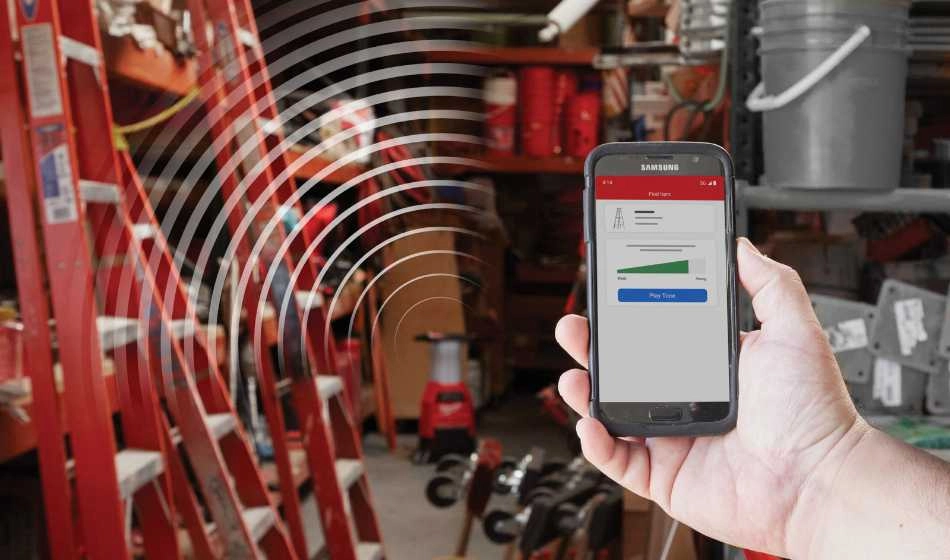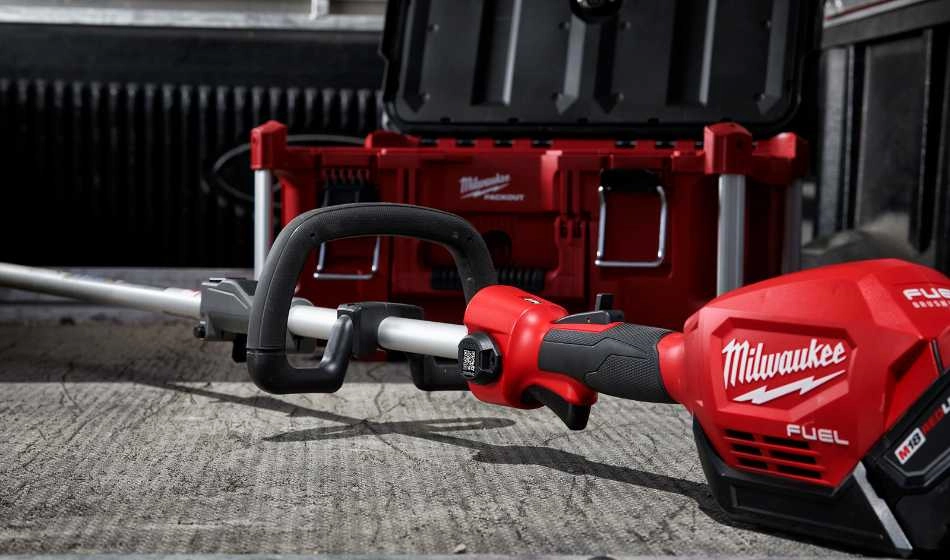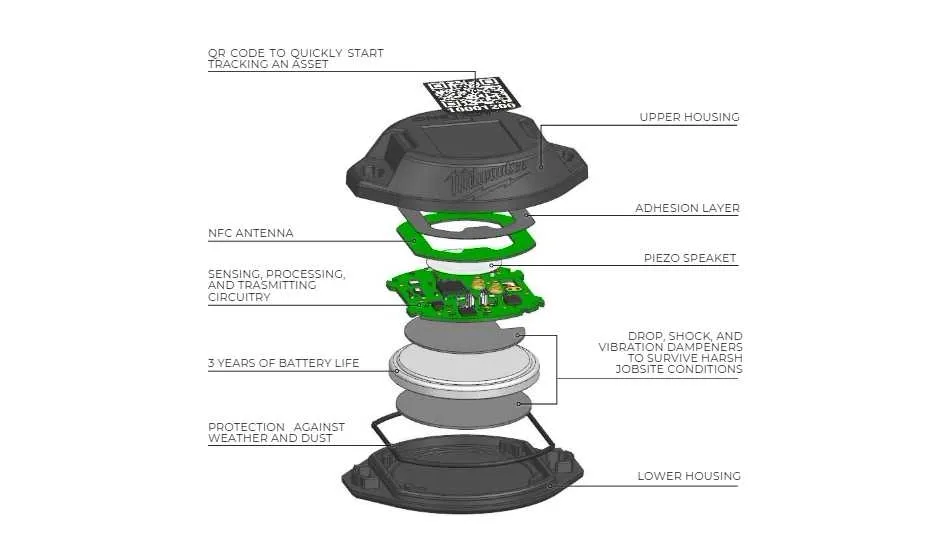In late 2022, Milwaukee Tool stepped on stage at the Chicago Innovation Awards to accept the Corporate Innovator Award.
What may have been surprising to some of the audience was the specific product for which we won the award.
No, it wasn't a powerful new cordless tool, a robust line of accessories, or a new-to-world hand tool design. Instead, it was a Bluetooth® tagging device – the ONE-KEY™ Tracking Tag.
Construction Equipment Tracking, Disrupted
For software engineers and electrical engineers in particular, opportunities at Milwaukee Tool extend beyond remarkable company stability and career growth. In particular, the construction industry that we focus on is just now shifting to digitalization – creating a plethora of unique project challenges and opportunities for our engineers.
While consumers across the world already rely on interactive and instantaneous experiences offered through IoT, it's only recently that this technology has started to make an impact on the construction industry. Building Information Modeling (BIM) software has already paved the way for users within the industry to utilize 3D design and modeling to optimize architecture, as well as mechanical, electrical, and plumbing (MEP) projects. But while there's been an increasing number of solutions like BIM to help plan materials and labor, when it comes to managing tools and equipment there are few good inventory management solutions.
The development of the award-winning ONE-KEY™ Tracking Tag is a great example of our teams continuing to harness IoT and application software to engineer progressive solutions for the construction industry.
But the Tracker's development wasn't exactly a 'walk in the park.'
Traditionally, the construction industry has most commonly tracked tools and equipment by:
- Employing cumbersome spreadsheets (or, even, notebooks)
- Utilizing expensive barcode scanners and flimsy barcodes that frequently wear out, are difficult to scan, or fall off.
Recognizing these issues, our team of engineers was challenged to create a solution that would be the most effective Bluetooth® tool and equipment tracker.
Requirements were that it had to:
- Offer digital inventory management and accessibility via smartphone, tablet, or computer.
- Be simple to use
- Provide accurate & reliable tracking
- Track when an item is last used/moved
- Provide alerts for better differentiation
- Be relatively small – fitting on everything from a drill to a jobsite storage box
What They Did
Digital inventory management and accessibility
This was the easiest of the requests. Since we first introduced it in 2015, the ONE-KEY™ connectivity platform is one of the construction industry's largest custom-built, cloud-based programs – providing the team with a perfect solution to integrate into, and support, these aspects.
Simplicity
"We felt that this product should be simple enough that the users next step is self-evident or guided by the software," said Dillan Laughlin, Sr. Manager of Software Engineering.
To ensure this ease of use, the team included a QR code that can be scanned with a mobile device (versus additional equipment) and automatically kicks off the entire pairing process, so the user can begin tracking an asset in seconds. In fact, the team developed a new test for simulating the wear and tear of various barcodes and QR codes to prove the durability of our QR code and that it would stand up to harsh conditions on the jobsite.
"If the user doesn't have the app on their phone, scanning that QR code will automatically direct them to the app store to download the app. It takes them to that next logical step, so they don't have to wonder what's next," said Laughlin.
Accurate & Reliable Tracking
Two different technologies were used: Bluetooth® and NFC. Advances in Bluetooth® chipsets allowed the team to build a 300ft tracking range into the product. NFC was used to provide another path for entry for users to set up the device. In particular, NFC allows users to interact with their Tracker even after the battery has died and BLE is no longer working. This also enables our engineering teams to make more data-informed decisions on future iterations of the product.
Tracking Usage
"We had to develop an algorithm that could efficiently determine when a tool is in use and not in use," said Lienau. "It sounds simple but, when you think about it, you're trying to differentiate between picking up and moving a drill (for example) from one place to another versus the actual activity of drilling."
The resulting onboard accelerometer helps to deliver richer context about where items were last seen and last used.
Alerts
The team knew that they needed to incorporate a speaker (of sorts) so that users can quickly identify a specific item when mixed in with others – even amid a crowded, loud jobsite.
"We found we couldn't get the volume we needed with little, off-the-shelf buzzers so we designed a small sound chamber and mounted a Piezo speaker on there to generate the sound," said Johnny Lienau, Sr. Manager of Electrical Engineering.
This was no small feat. Since the sound chamber provided access to the 'outside world' through a small hole to let the sound out, the team also needed to get creative about how to waterproof the entire Tracker. Additionally, since the sound chamber was above the main circuit board, they also cleverly incorporated spring-loaded contacts to transfer the electric signal from the main circuit board up to the Piezo.
The resulting speaker was a critical component that Laughlin and his team could then leverage from the software side to create a better 'last-hundred-foot experience.'
"When someone is trying to find their tool, you don't want them wandering around the jobsite just looking at a map on their phone that may or may not be super accurate. That's where things like the speaker come into play," said Laughlin. "There's multiple tones that you can play on the speaker when you're trying to locate your tool. This helps account for different jobsite conditions where you're going to be able to hear different ones based on the ambient noise around you."
Laughlin's team was also able to create a signal strength meter so, as users walk around looking for their item, improved signal strength would indicate they're getting closer to it and can fire up the speaker.

Small Form Factor
"Putting all of this into the Tracker involved some complex mechanical and electrical engineering design work. We had to fit this coil in there, and fit it into a small form factor," said Lienau. "At Milwaukee® we're so used to working on larger tools. But for this project we needed really fine, detailed engineering to fit everything in this package."
From there, it fell on the mechanical engineers to figure out how to take all this hard work and ensure the surrounding package had the durability and IP rating to withstand the harsh jobsite environment.
It was hard work that paid off in dividends. Outside of the reputable Chicago Innovation Award, the Tracker has received both positive feedback from end users and industry reviewers.
- Jobsite equipment rental companies and major manufacturers have been seen using the Tracker to better manage their assets and enhance their user experiences. The Tracker has also been used outside of the construction industry, in the facilities and operations departments at major universities as well as at large companies.
- The product also earned a Pro Tool Innovation Award, among the most reputable product awards in the construction industry.

Milwaukee Tool: An Engineer's Playground
The Milwaukee Tool brand has a storied history of innovation. But while we've typically been known as the fastest-growing manufacturer of power tools, hand tools, storage, and accessories, our attention to harnessing new technology to address user needs has fundamentally reshaped us into a jobsite technology solutions leader over the last decade.
Modern power tools are a far cry from their corded and gas-powered predecessors. The innovation necessary to manufacture tools like this takes a lot of engineering expertise across many disciplines. Power and battery technology, wireless connectivity, and even artificial intelligence are all actively a part of the research and development of these tools. In fact, we firmly believe that smart tools are going to define the next decade of the power tool industry. This requires us to find talented people with embedded systems, firmware, data science, software engineering, and machine learning backgrounds.
For years, these types of high-skilled engineering talent have flocked to companies more traditionally thought of as 'tech companies.' As an example, surveys (e.g., Indeed, Universum via Insider, Zippia via CNBC) that report out companies "most attractive" to engineering students have consistently handpicked household tech giants like Microsoft, Google, and Tesla. Also among these surveys are high-tech companies in future-forward industries like aerospace and aviation (e.g., LockHeed Martin, SpaceX, and Boeing).
However, while many of these tech companies are seen reaching their hypergrowth plateaus, Milwaukee Tool has shown positive growth (delivering 22% sales growth in 2022), and we've seen a decade's worth of double-digit growth. Additionally, a recent list curated by decision intelligence and market research company Morning Consult ranked Milwaukee Tool 5th among the top 20 fastest growing brands of 2022.
Andy Davis, Group Manager of Electronics Engineering, believes this to be a major reason engineers give us a second look.
"While we've had a lot of growth, compared to [companies like] Apple or Facebook, we have retained the agility, speed, and opportunity more commonly seen in start-ups. There's a shorter path to ramp up our engineers… You get to come in and do some very meaningful work right away, see the progress, and see where it's going. Along the way, you gain a lot of the building blocks to go into the next technical project or the next leadership role quicker than you would see at some of these other companies," Davis says.
An Innovation Incubator in the Heart of Chicago
Our newest location in Chicago's historic Old Post Office serves as a Design and Innovation space for teams like Davis's, Lienau's and Laughlin's. It's one of just the latest major investments we've made to support new technology development.
It's the perfect place for these teams to continue to grow, as Chicago's technology scene is rapidly growing. For example, according to Chicago Inno, Chicago's tech sector has grown 18% in the last 10 years (compared to the city's broader economy that grew just 1%).
Andy Davis describes the Chicago office as not a siloed entity, but rather as "an extension of what we're doing in Brookfield" (our main headquarters in Wisconsin), explaining "it's given us the flexibility of finding skilled engineers on the hunt for challenging new types of work."



